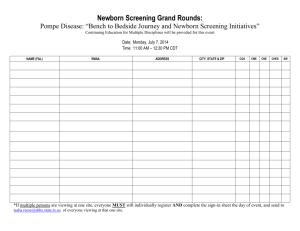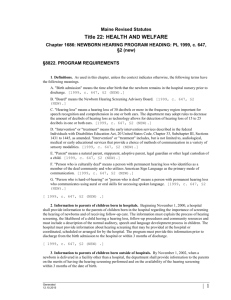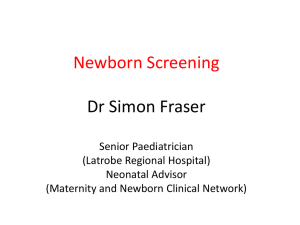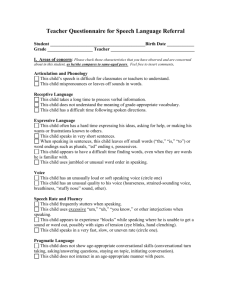Consensus Statement - The Paediatric Society of New Zealand
advertisement
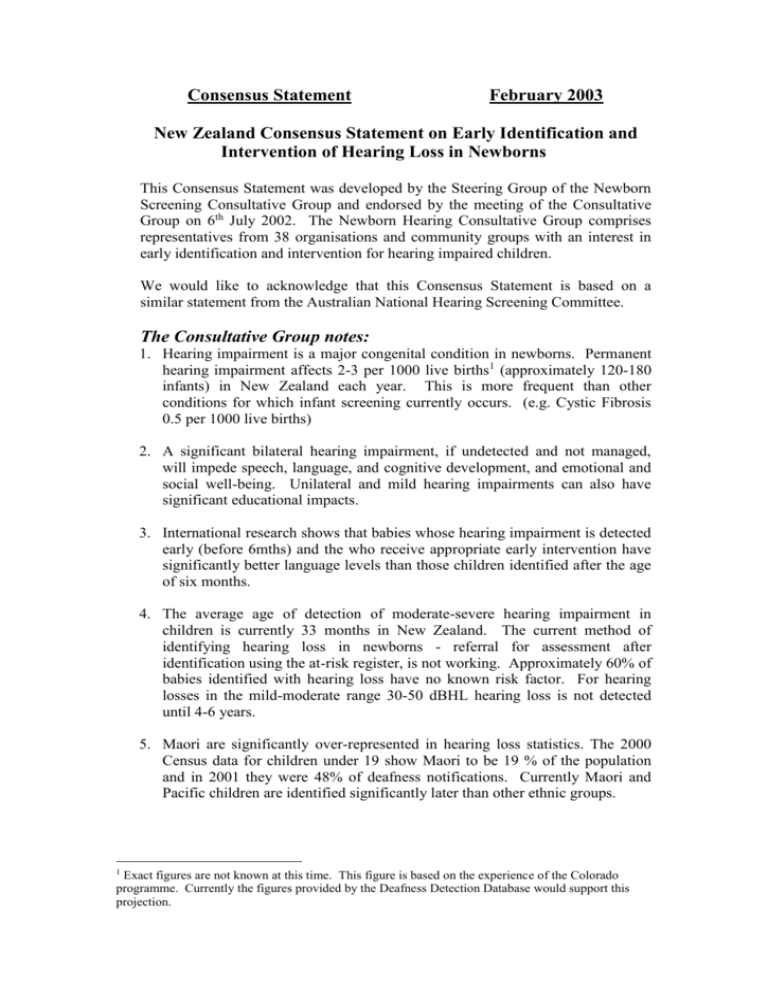
Consensus Statement February 2003 New Zealand Consensus Statement on Early Identification and Intervention of Hearing Loss in Newborns This Consensus Statement was developed by the Steering Group of the Newborn Screening Consultative Group and endorsed by the meeting of the Consultative Group on 6th July 2002. The Newborn Hearing Consultative Group comprises representatives from 38 organisations and community groups with an interest in early identification and intervention for hearing impaired children. We would like to acknowledge that this Consensus Statement is based on a similar statement from the Australian National Hearing Screening Committee. The Consultative Group notes: 1. Hearing impairment is a major congenital condition in newborns. Permanent hearing impairment affects 2-3 per 1000 live births1 (approximately 120-180 infants) in New Zealand each year. This is more frequent than other conditions for which infant screening currently occurs. (e.g. Cystic Fibrosis 0.5 per 1000 live births) 2. A significant bilateral hearing impairment, if undetected and not managed, will impede speech, language, and cognitive development, and emotional and social well-being. Unilateral and mild hearing impairments can also have significant educational impacts. 3. International research shows that babies whose hearing impairment is detected early (before 6mths) and the who receive appropriate early intervention have significantly better language levels than those children identified after the age of six months. 4. The average age of detection of moderate-severe hearing impairment in children is currently 33 months in New Zealand. The current method of identifying hearing loss in newborns - referral for assessment after identification using the at-risk register, is not working. Approximately 60% of babies identified with hearing loss have no known risk factor. For hearing losses in the mild-moderate range 30-50 dBHL hearing loss is not detected until 4-6 years. 5. Maori are significantly over-represented in hearing loss statistics. The 2000 Census data for children under 19 show Maori to be 19 % of the population and in 2001 they were 48% of deafness notifications. Currently Maori and Pacific children are identified significantly later than other ethnic groups. 1 Exact figures are not known at this time. This figure is based on the experience of the Colorado programme. Currently the figures provided by the Deafness Detection Database would support this projection. 6. Early identification (before the age of 3 months) is now feasible using objective, physiological screening techniques (otoacoustic emissions and automated auditory brainstem response) at birth, followed by diagnostic physiological and behavioural audiological tests in babies that do not pass the initial screening. Overseas programmes have shown it is possible to achieve coverage rates approaching 100% and false positive rates as low as 2%. 7. Centres in the USA where newborn screening has been implemented have reduced the detection and diagnosis time to below 3 months. 8. The American National Institutes of Health Consensus Statement, 1993, the European Consensus Statement, 1998, the American Academy of Pediatrics, 1999, the US Joint Committee on Infant Hearing, the Australian Newborn Hearing Screening Committee 2002 have all supported the introduction of screening. It is mandatory to offer newborn screening in most states of the USA. Universal newborn hearing screening is being implemented nationally throughout England and Wales. A large scale trial of newborn hearing screening is currently under way in Western Australia and about to begin in NSW. The Newborn Consultative Group proposes that: 1. Universal newborn hearing screening of infants is feasible, beneficial, and justified. 2. Principles of equity and efficiency demand the establishment of a high quality programme of universal newborn hearing screening in New Zealand as soon as possible. This will reduce current inequities in age of detection for different ethnic groups. 3. Prompt audiological assessment must be achieved for all neonates identified by hearing screening and prompt, effective intervention must follow for those in whom the impairment is confirmed. 4. To be effective, a newborn hearing screening programme should be culturally appropriate for all groups and in keeping with the principles of the Treaty of Waitangi be universal (i.e., include all newborns), since selective screening based on high-risk criteria in practice detects at most half of all infants with congenital hearing loss. achieve high coverage and follow-up rates, relative to the total number of births in the population. be coordinated and comprehensive in its approach, i.e. it should include training and supervision of personnel, full and accessible information for parents at all stages of the programme, quality assurance, the follow-up of identified children, systems for reporting and monitoring outcomes, and counseling for parents of children with hearing impairment. 5. Models for the delivery of a newborn hearing screening programme need to be designed to take account of New Zealand patterns of population distribution and service delivery. 6. Effective universal newborn hearing screening will not replace the need for vigilance and for continued surveillance of hearing behaviour and language development to detect hearing impairment in children who have not received newborn screening or who develop permanent hearing loss at a later age. The Newborn Consultative Group resolves that: 1. A program of universal newborn hearing screening should be introduced throughout New Zealand in order to detect children with hearing loss at the earliest possible age. 2. A Hearing Screening Committee should be established and with The Ministry of Health should work with the Stakeholder groups and community to establish a coordinated screening programme. This process should be initiated by establishing pilot programmes around the country. 3. A universal hearing screening programme must be sufficiently resourced to enable high quality monitoring and evaluation. 4. A nationally coordinated approach will be necessary to achieve effective and efficient universal newborn hearing screening programmes for all children in New Zealand. 5. Clear time lines should be specified for the planning and implementation of universal newborn hearing screening in New Zealand. 6. The Ministries of Health and Education and the Stakeholder groups should work together to ensure audiological assessment, diagnosis and habilitation occurs at the earliest possible age, and that excellent support should be achieved for all New Zealand children identified with hearing impairment.

